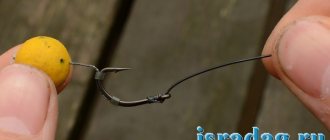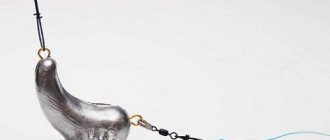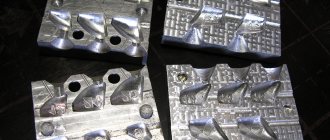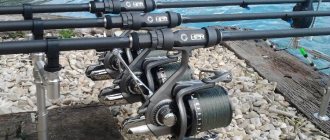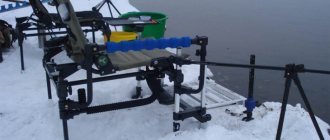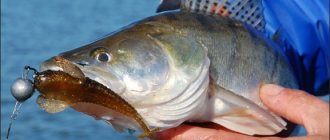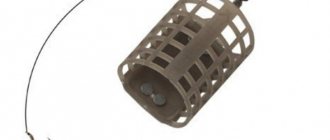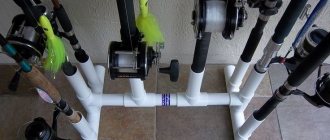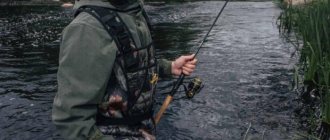Donka refers to simple ways of catching fish that live in the bottom layers of water. The simplest types of bottom gear have been used by people for a long time, during which time it was possible to find the best options for fishing in currents and still water. Bottom tackle for fishing in currents from the shore helps to catch large species of fish: bream, carp, carp, crucian carp, etc. Classic equipment with intense water flow turns out to be ineffective, but improved modifications can bring a good catch of large fish.
Rules for choosing gear
The unifying factor for all donks is the possibility of catching fish feeding in the bottom layer and from the bottom of the reservoir. But this does not mean that all donks are the same and that gear for the current also differs from each other.
The use of one or another equipment depends on:
- fishing conditions;
- season;
- distance to point;
- availability of watercraft.
There are also universal bottom tackles and, for example, they can fish with a feeder both from the shore and from a boat, both in summer and winter. But in each case, the advantages and disadvantages of the equipment manifest themselves, and in summer or autumn it is more convenient to fish from the shore to the feeder. But you can’t fish from the shore with a winter bottom, so when choosing equipment, all factors are taken into account.
It is easier to knit primitive hooks or nipples, but the fishing efficiency with such equipment is much lower, so you need to choose what is more important. Fishing with a boat is more convenient, because you can choose any place on the reservoir, but you need to use bottom gear with rods.
Varieties of donks for currents
The following are considered catching gear for the current:
- classic donka with a rod and spring;
- casting without a rod;
- running donka;
- carousel;
- "crucian carp killer";
- donka for fishing from a boat with a ring;
- feeder tackle (including method);
- makushatniks;
- donks on a predator;
- "nipples".
The main difficulty when fishing on the current is to choose the right sinker. You should not use a load that is too heavy, but it should not be carried away by the current either. The weight of the load should be such that the tackle lies on the bottom in a calm state, but upon contact with the fish it immediately transmits information about this to the fisherman. A cautious fish, having picked up and pulled a leash with a heavy load, will immediately become wary, drop the bait, and no hooking will occur.
Requirements for bottom gear
The main requirements for any bottom current equipment:
- sensitivity;
- functionality;
- compactness;
- reliability.
Strong river fish breaks off incorrectly tied and unreliable equipment, and the fisherman is left without a trophy. Therefore, each element of the donkey must be functional and durable. This applies to fishing lines, hooks and rods, and all components are responsible for their functions.
It is not necessary to purchase the most expensive gear, but its reliability must correspond to the assigned tasks. Another advantage of fishing with donks in the current is that the fisherman can only guess how big the fish he will catch will be.
When fishing for crucian carp or bream, carp and even catfish are caught on the hook, and this fish is much larger and more powerful. Therefore, it is important to be ready for the trophy, and this depends on the reliability of the gear.
The interchangeability of elements in the equipment is also important, because fishing conditions vary, and sometimes you have to change weights or leashes due to cliffs or weather conditions. If the bite is good, you don’t want to waste time on such things, and it’s better to take a supply of rigs with you.
Float
This type of fishing sinkers is relatively rare, but their correct selection is no less important for effective fishing than determining the hook size. In most cases, the following types of weights are used for fishing with float gear.
Pellet
When installed in a certain way, this element of equipment is also called a feeder, or a bite sinker. It is used to give the correct position to the float, and also largely influences the behavior of the bait under water. The pellet is placed between the float and the hook, and its size and location determine both the draft of the surface part of the equipment and the force with which the current acts on the hook and the bait on it. The lower the load goes, the more passive the bait is and vice versa. In addition, to increase the weight under changing fishing conditions, you can use several pellets at once, which will not affect the behavior of the worm or maggot on the hook as much as increasing the weight of a single weight.
Olive
This type is successfully used for both bottom and float gear. In this case it is a sliding sinker. Depending on the type of installation, it can be attached to the fishing line both before and after the float - this radically changes the behavior of the equipment under water. This type of loading is used both on currents and on still waters, when it is necessary to cast the equipment as far as possible. Due to the high windage of the float, in this case it is impossible to do without a heavy olive. In addition, it is usually accompanied by a feeding pellet to influence the action of the bait.
Using an olive located below the float helps lower the bait to the very bottom, which is especially important when fishing in fairly strong currents.
Sheet lead
Homemade versions of loading on float rods are most often made from this material. Its weight is quite easy to change depending on fishing conditions, and attaching a sinker made of sheet lead to a fishing line is as simple as possible.
Sinkers for float rigs are usually purchased as a set, which contains a large number of pellets of different weights. In this case, it is very convenient to choose the appropriate weight, especially if the weights are sorted in a box. It’s worth adding several olives of different sizes to them in case of fishing in the current, and you can be sure that you can assemble the right equipment for any fishing conditions.
Tackle without rods for current
There are current donks that do not have a rod in their design, these include:
- "rubber bands";
- snacks;
- carousels.
The advantages of such donks are their compactness, because they are more convenient to transport and store due to their small size. The reels on which such donks are wound have a design that allows them to be secured to the shore and held firmly.
When a river fish bites strongly, there is a chance that the tackle will be pulled into the water, so you need to secure it well and monitor the condition of the reel. They fish with donkeys without rods from the shore; it is more convenient both for casting and controlling the tackle, and for fishing.
Inertia-free reels, which are required for a feeder, are not needed on a cast or elastic band; this simplifies the design of the tackle, but complicates pulling the fish to the shore.
Rubber
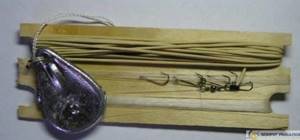
The design of the elastic band throw for the current has a rubber shock absorber, thanks to which you don’t have to throw the tackle all the time, it goes into the water itself, and in the right place.
The disadvantage of fishing with a bottom rubber band in the current is that the shock absorber is stretched under water pressure and it is difficult to achieve good accuracy. An elastic band is more of a tackle for still waters, although there are many anglers who use it on rivers with a current.
Carousel
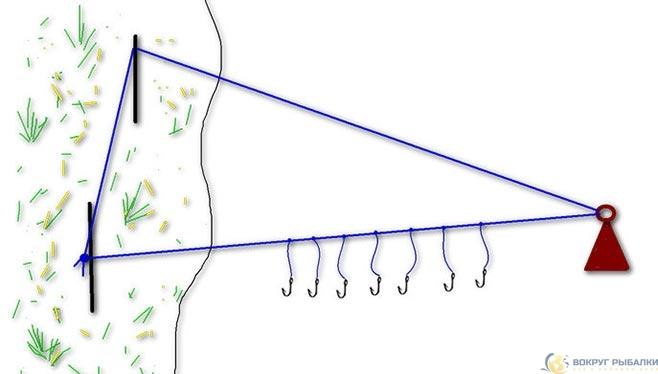
The tackle is similar to an elastic band in that it is equipped with 5–10 leashes with hooks, there is no fishing rod, the load is carried on a boat and the equipment is pulled into the water. Let's imagine a double-tied fishing line stretched into the eye of a weight located at the bottom of a reservoir.
When one of the parts is pulled, the other, to which the leashes are attached, also moves and goes into the water. After this, the fishing line is fixed on the reel, the alarm is set and all you have to do is wait for the bite. After the alarm goes off, all you have to do is pull the fishing line with hooks, and it will go to the shore, pulling the other end into the water.
After the angler removes the caught fish and re-hooks, the process is repeated. The donka carousel is more convenient for the current than an elastic band, because it does not stretch out in the water, but it is difficult to catch trophy fish with it due to the roughness of the equipment.
Mushrooms and nipples

Similar multi-hook rigs are used both in still waters and in currents and show good results. True, you will have to be patient and wait for a bite, because the principle of operation of the gear is based on the fact that the bait or a cube of macaque is washed away and attracts fish.
Having come to feed, the fish are hooked with one or more hooks on which foam is mounted, providing good buoyancy. The fluff takes a long time to wash away, and bait in the nipple is not much faster, although when fishing in the current this process is, for obvious reasons, accelerated.
But trophy fish are caught both on tops and nipples, which are not afraid of noise on the shore or rough elements of equipment. So such gear is used for fishing in the current, with or without a rod and reel, on hooks.
Tackle with rods and reels
Bottom tackle for currents with a rod is more convenient when casting over a long distance. There are fishermen who cast a regular bait far, but even in this case the fishing distance is shorter, and this limits the possibilities.
It’s hard to imagine an angler constantly casting a bait 80+ meters, but when fishing with a feeder it’s not at all difficult. Trophy fish still often stay away from the shore, so using current donks with a rod has advantages.
The role of a spinning reel, which helps in casting and retrieving large fish, is also important. Thanks to the presence of a drag and a bait trainer with such a reel, you can use thin fishing lines and not lose the fish due to a strong jerk.
Bottom tackle for current with a rod and spring feeder

A donka with a spring is the simplest gear for fishing in the current with a rod, but with its help they catch both roach and catfish, that is, fish of very different sizes. The differences in equipment for catching large fish or small fish are not so fundamental, so we consider the equipment in general terms.
To make a flow donut with a spring you will need:
- rod;
- coil;
- fishing line;
- installation with sinker, spring, leads and hooks.
Rod
Any rod can be used for long casting, allowing you to fish with loads weighing up to 150 grams. Whether it is a telescopic or a carp is not so important, although the first option is more compact for transportation. The length of the rod is a characteristic that affects the fisherman’s convenience in working with the blank, as well as the casting distance and convenience when landing fish.
When fishing for bream at 40-60 meters, a “telescope” 3.00–3.30 meters long is sufficient. But when increasing the distance, to make it more convenient to cast, take a 3.60, or even 3.90 meter fast action rod with a rigid blank.
If the distance increases beyond 80 meters, you need a carp rod, two or three-part, because strong throws will be required and the telescopic rod simply will not withstand the load. There are also telescopes on sale for carp fish, and this is the best option for fishing conditions in the current, at a distance of more than 80 meters.
Coil
When fishing in the current, the reel experiences serious loads and therefore its power and reliability are extremely important. A good reel is especially important when making a donk for a river with a very fast current, because in addition to the resistance of the fish and the weight of the load, the mechanism is subject to pressure from the flow of water.
“Pumping out” with a rod when landing fish is mandatory, as is working with a friction clutch, which facilitates the process and preserves the functionality of the reel. When fishing in a current, the rig does not use a shock leader and, accordingly, the fishing lines are chosen thicker than in carp fishing.
Therefore, the size of the reel spool should be enough to wind 120–150 meters of relatively thick fishing line. A strong cast with a reel with a spool diameter of 4000–5000 is easier to do, and if the spool is 6000, then the fisherman will have fewer problems.
These are general recommendations and each angler selects a reel according to his financial capabilities and personal preferences, but a good reel is more reliable and will last longer. A big mistake is made by an angler who buys a cheap but unreliable reel for fishing on the current, because due to serious loads, very soon it will have to be changed, and this is an extra expense.
fishing line
At first glance, it seems that choosing a fishing line for a donkey is very simple, especially since there are many models in stores in different price categories.
But there are requirements that the fishing line must meet:
- strength;
- stealth;
- abrasion resistance;
- resistance to aggressive environments;
- price.
The current carries the tackle with the load, and it drags along the bottom, and the fishing line experiences extreme loads and its abrasion resistance is extremely important. A small snag on a stone or an unnoticeable burr will be enough for an offensive breakage of the equipment when landing fish.
It is difficult to control the condition of the fishing line after each cast, especially along its entire length, and there is no confidence in reliability. The color of the fishing line is selected depending on the shade of the water. At the same time, in the spring the water is cleaner, and in the summer it turns green with algae, so the colorless base will be universal, for any season and occasion.
There is no need to even mention the strength, and there are many fishing lines from Russian, Hungarian, and Polish manufacturers with good characteristics and low cost. A diameter of 0.28-0.3 mm will be quite enough, because a line that is thinner will not withstand a force cast, and a fishing line that is too thick will not cast far. So there is something to choose from and all that remains is to carefully consider the offers and choose the best according to your requirements.
Important! Increasing the thickness of the fishing line reduces the casting distance. In addition, a thick fishing line floats more strongly in the current.
Rigs for fishing on the current
Mounting is an element of the donkey that is in direct contact with the fish, and it is tied on a separate piece of fishing line 40–50 cm long. The fishing line for mounting is taken 0.05 mm thinner than the base.
This choice is preferable, since if it gets caught and it is necessary to pull the equipment by force, only the installation itself will break, and the entire main line will remain intact. At the same time, installation is difficult, especially if the feeder is filled with bait and the fishing line must support it, so a thickness of 0.23-0.25 mm is sufficient.
A simple setup for fishing in still water uses a loaded feeder weighing 40–50 grams. This is not enough for the flow, so take a light spring and a flat sinker weighing 80–120 grams. The shape of the sinker should help keep the tackle on the bottom in the right place, and its weight, as well as the weight of the bait in the spring, is enough for comfortable fishing.
So, to knit a rig for fishing in the current you will need:
- fishing line 40–50 cm with a diameter of 0.23-0.25 mm;
- flat, sliding sinker 80–120 grams;
- dummy spring;
- rocker for leashes;
- two leashes 3–4 mm long on soft leash material or cord;
- one leash 5–7 mm long on a fishing line;
- float stops;
- 2 swivels number 8.
The use of a rocker arm in installation is necessary to prevent tangling of the leads and to correctly position them on the bottom.
Important! When tightening knots on the line, be sure to wet them to prevent breakage. At the moment of tightening, the line on the knot becomes very hot and melts.
We knit the installation for the donka:
- tie a swivel to one end of the fishing line;
- put a sinker on the line and pull it to the swivel;
- put on the float stopper and stretch it to the sinker;
- put a spring on the fishing line;
- put on the float stopper and stretch it to the spring, leaving 3–5 cm;
- tie a swivel 2–3 cm above the stopper;
- tie a leash made of fishing line to the swivel;
- tie a rocker arm to the lower swivel;
- tie leashes with hooks to the rocker arm;
- make a loop at the free end of the fishing line for tying to the base.
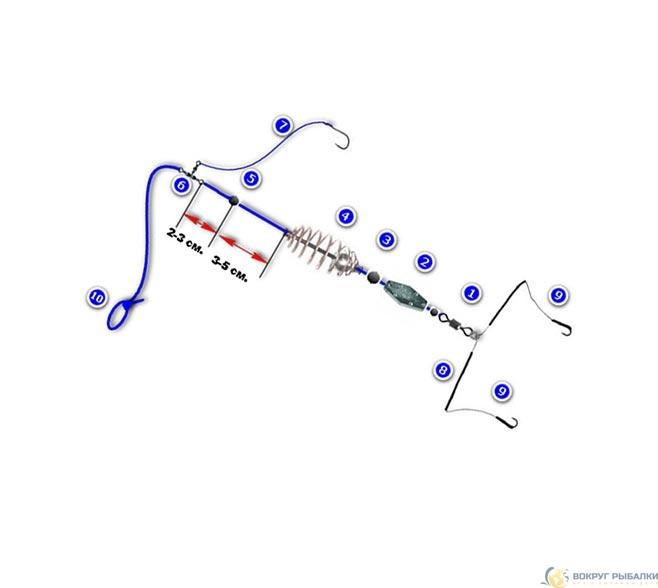
This installation has good flight properties. In this case, the spring moves along the fishing line and when the fish becomes interested in the bait, nothing will scare it away. Soft leashes on the rocker float freely in the water and will easily fly into the fish’s mouth when bitten.
The upper leash is knitted from fishing line so that it does not get tangled with the base when casting. The length of the leash with fishing line does not exceed 7 cm, this is also necessary so that the tackle does not get tangled. With this type of installation, the leashes are quickly changed, the main thing is to have a reserve in the leash holder.
When fishing on a rocky bottom, hooks quickly become dull, and the ability to quickly change them will save the angler time. When you manage to get a good bite, every lost minute is valuable, so replaceable leashes help increase the size of the catch. The size of hooks for donkey is selected depending on the fish that you plan to catch.
Matte hooks 8–14 numbers are suitable for fishing:
- crucian carp;
- bream;
- roach;
- perch
But for carp or catfish you need larger hooks and better ones with anti-reflective coating. It is very interesting to catch large and cautious fish on a donkey with a spring, but all elements of the equipment must be reliable and inconspicuous.
Important! Monitor the condition of the hook, especially when fishing on a rocky bottom. At the first sign of dullness of the hook, it should be changed.
